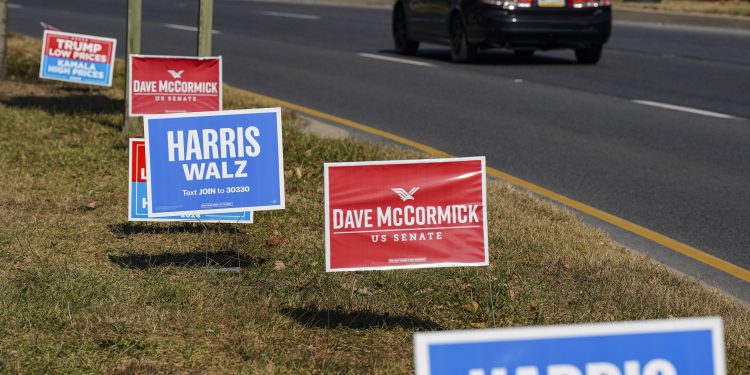The recount of roughly 7 million ballots in the U.S. Senate race got fully underway this week, with some counties already finished.
Carter Walker of Votebeat
This article is made possible through Spotlight PA’s collaboration with Votebeat, a nonpartisan news organization covering local election administration and voting. Sign up for Votebeat’s free newsletters here.
Many Pennsylvania counties had already finished retabulating ballots Wednesday and Thursday as the recount of roughly 7 million total ballots in the U.S. Senate race got fully underway.
Among counties that have finished their recounts are Chester, Lebanon, Somerset, Cambria, and Allegheny, while Philadelphia is expected to wrap up this week. The Pennsylvania Department of State said results will be announced via news release on Wednesday.
The Pennsylvania Department of State said Thursday afternoon the initial count of votes in all counties had been completed. As of 5 p.m., incumbent Democratic Sen. Bob Casey trailed Republican challenger Dave McCormick by 16,349 votes, or a margin of 0.24%, compared with about 0.43% a week earlier.
Since 2004, state law has automatically required a recount when the margin of a statewide race is within 0.5%, unless the losing candidate waives that right. None of the seven previous recounts triggered by the 0.5% rule resulted in a change of outcome, according to the Department of State. The last statewide recount also involved McCormick, who lost the Republican primary for U.S. Senate in 2022 to Mehmet Oz by fewer than 1,000 votes.
FairVote, a national nonprofit focused on ranked-choice voting, analyzed nearly 7,000 statewide races around the country between 2000 and 2023 and found 36 recounts in that time, only three of which resulted in a change of outcome. All three of those reversals occurred when the initial margin was within 0.06%.
Casey has drawn criticism from the right for not conceding the race earlier so the state could avoid a costly recount. McCormick made the same choice in 2022, Gov. Josh Shapiro noted earlier this week.
All 67 counties must recount each ballot cast in the race and be finished by next Tuesday.
The campaigns have also been battling across the state over which provisional ballots should be counted. Those are the ballots cast by people whose eligibility is in question.
Recounts can be expensive — the department estimates this year’s recount will cost the state more than $1 million — and labor-intensive for counties.
Still, election officials and outside observers say recounts and audits can serve purposes that go beyond settling the outcome. They can help reveal problems with the original ballot counts, illuminate how to process votes more efficiently, and provide confidence in results for voters and candidates.
Pam Smith, CEO of Verified Voting, a nonpartisan elections technology organization, said that recounts, done in conjunction with post-election audits, serve as an important double-check on the accuracy of the election process.
“It’s rare for an audit or even a recount to uncover a variance, but sometimes there can be an error or some outcome-changing factor that can lead to a result being overturned,” she said.
She noted a 2012 incident in Florida where an audit uncovered a programming error, and led to a recount that eventually changed the outcome of the race.
People may complain about the cost, especially since the outcome rarely changes, she said, “But you don’t know that. … And if it leaves everybody with a sense of certitude, a sense that ‘Yes, now we know for sure,’ that’s actually a good thing.”
Seth Bluestein, a city commissioner in Philadelphia, noted the recount process offers a glimpse of what Election Day mail ballot counting could look like if counties were able to prepare ballots for counting ahead of time. The city was tabulating roughly 20,000 ballots per hour Wednesday morning, more than twice the speed it was able to achieve on Election Day.
In Philadelphia on Wednesday, two-person teams each operated one of 14 high-speed scanners to process the hundreds of thousands of ballots the city needed to retabulate.
State law dictates that during a recount, ballots be counted using a different method than was used to count them initially. Philadelphia achieved this by organizing its batches of ballots on metal racks with signs that indicated which machine those batches needed to be scanned on.
A worker would retrieve a batch of ballots, which are kept in a sealed file box, and bring it back to their machine. The workers then cut the seal, removed the ballots, and tapped the stack of ballots on the table like a deck of cards to ensure they were all lined up and would not cause a jam in the machine. Once the scanning was done, they put the ballots back into the box, applied a new seal, and returned the box to a pile with other completed batches.
The entire process for one batch took less than 10 minutes, but there are hundreds of batches to get through.
Carter Walker is a reporter for Votebeat in partnership with Spotlight PA. Contact Carter at cwalker@votebeat.org.
BEFORE YOU GO… If you learned something from this article, pay it forward and contribute to Spotlight PA at spotlightpa.org/donate. Spotlight PA is funded by foundations and readers like you who are committed to accountability journalism that gets results.




